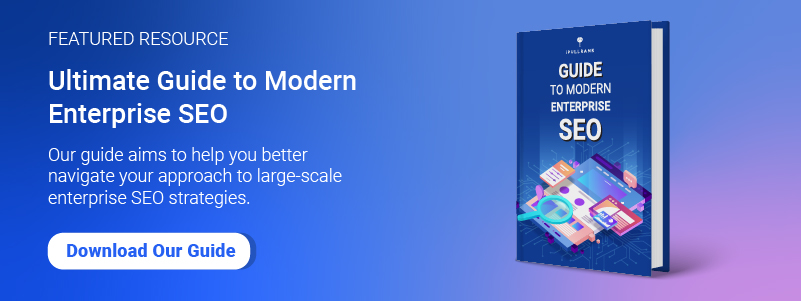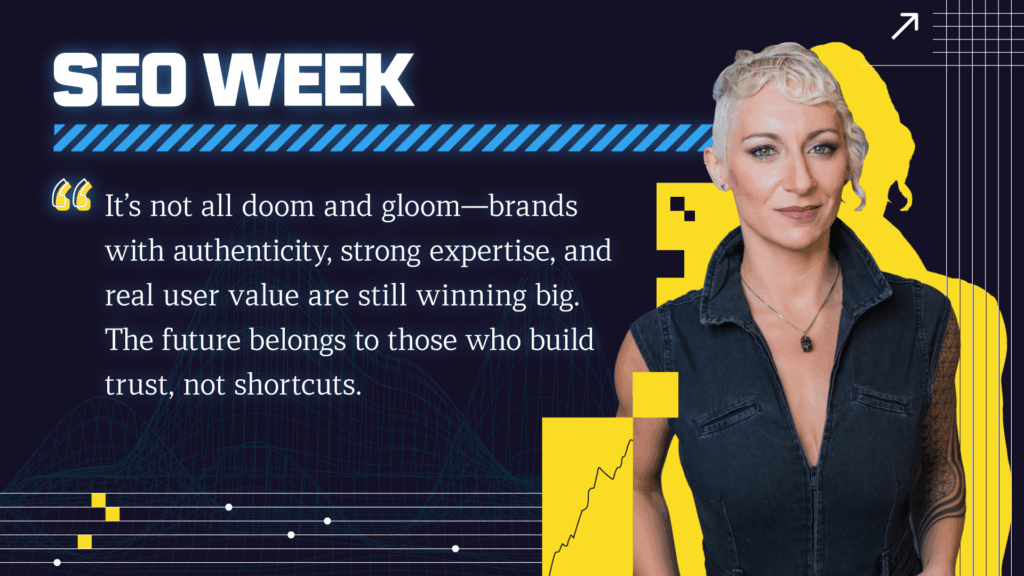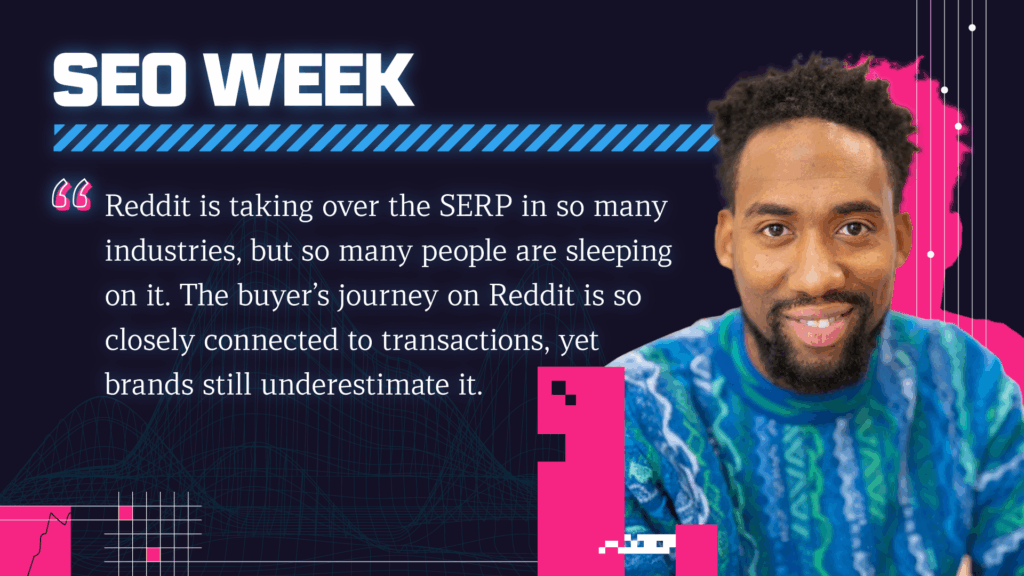You’re in the market for an enterprise SEO agency.
You’ll want to vet contenders.
There’s a wide variety of criteria that you can (and should) use to vet your SEO agency; however, there are five must-haves you’ll need to ensure your agency search campaigns are successful.
If you have these, your agency can work miracles.
Today, we’ll look at some of the critical processes, resources, and expertise that your enterprise SEO agency needs to achieve the kind of stellar and consistent results you’re looking for.
Must-have #1: Build a content pipeline for 10x content
Content and SEO aren’t separate.
This might sound like heresy.
However, seasoned marketing professionals like Samuel Scott agree that content marketing and SEO have both received the buzzwords treatment. In his view, nothing about marketing has changed except the addition of two new channels (the internet and mobile).
Here’s how Scott describes marketing and content.
“Marketing has always been the creation of a message, the insertion of that message into a piece of content and the transmission of that content over a channel to an audience in an effort to build brands, increase demand and move people down sales funnels. The same is true today — the only differences are that we have two additional sets of available channels, called the internet and mobile devices, and those channels allow for a greater variety of content formats.”
What’s this got to do with SEO?
Many professionals treat SEO as a kind of crystal ball when it’s actually a helpful barometer. It’s a barometer that makes marketing incredibly convenient.
You’re able to:
- Identify (with precision) the specific stages of the searcher’s journey; (a.) Informational searchers want info, (b.) navigational searchers – are looking for a particular destination, and (c.) transactional searchers are looking to convert, whether that’s a purchase, download, sign-up, or registration.
- View the exact keywords and phrases customers use to describe their problem or need. This enables you to create content that precisely matches the type of searcher visiting your site.
- Create content that aligns with your searcher; what does this mean? The searcher’s word choice, tone, and stage in the buyer’s journey give you a clear idea of the type of content you’ll need to create to attract and hold their attention.
- Reap the rewards. The better you are at meeting your searcher’s (customers) needs, the more you’re rewarded by visitors and Google. The former rewards you with sustainable traffic, inbound links, and social shares; the latter rewards you with increased visibility via better rankings.
If SEO is a barometer, this means you’re essentially using it to provide searchers with answers to their problems. But make no mistake, SEO is content; they’re different sides of the same coin.
How do we know?
Google can rank web pages with or without SEO.
In fact, there’s no such thing as ‘SEO Content.’ According to our own Mike King, your approach to content that ranks needs to be:
“What is it that people want to know and then what is it that these search engines would expect? Any content that you create should speak to a target audience. If you’re identifying your personas, your market segments, make sure that this content aligns with their expectations and their needs and their desires, and so on. It should also fit in the context that it’s meant for.”
Here’s the thing.
You know you have a lot of competition. They’re all looking to compete with you — they want to take the traffic, inbound links, and social shares you’re already getting.
How do you counteract that?
You build a pipeline for 10x content. You create a process that provides you with the structure you need to churn out 10x content for your clients. Here’s what that pipeline structure entails.
- Content topics/ideas: As this category suggests, these are the content pieces you’re researching. You’re working to verify that you (a.) have deep insights on the topics you have in mind, (b.) have a unique but compelling angle, and (c.) you have data-driven, difficult-to-copy answers for your audience. You’ll want to plan your content out over a specific duration that gives you the lead time you need to churn out consistent content; this can be quarterly, every six months, or annually.
- Approved topics/ideas: These are the proposed content pieces that have made it through the research process; these topics are interesting to your audience, and you’re aware of the impact your content is likely to have (e.g., audience growth vs. increased conversions). These content pieces are ready to be assigned to a specific writer or team member.
- Content in progress: These content pieces have been assigned and are in progress. Setting due dates for your first, second, or third drafts is a good idea. Rely on your editors to clean each piece up, so it’s compelling with maximum appeal to your readers and customers.
- Editor approval: Editors will need to verify that each draft adheres to the requirements laid out in your organization’s content and style guides. If there are any required changes, you’ll want to make those or send them back to your writer so they can make the necessary updates. If your focus is 10x content, you’ll want to make sure your content meets the criteria laid out below. Editors should verify that the on-page optimization for each piece is completed as desired.
- Update and schedule: You’re ready to upload and schedule your content for publishing at this stage. Once you’ve uploaded your content, take a minute to preview things, it’s common to find last-minute spelling errors or formatting problems. Next, set reminders so you can verify that scheduled content is going out as expected with no issues.
- Publish your content: At last, your content has been published. Give it a final once over and ensure that everything (e.g., images, content, formatting, layout, responsive design, etc.) performs as expected. If there are any issues, alert your team so you can make immediate changes.
- Content promotion: Promotion should take up 70 to 80 percent of your content marketing efforts. If you’ve invested a significant amount of time, resources, and money into your 10x content, you’ll want to, at a minimum, make the same investment to promote your content. Your promotion channels should be lined up ahead of time and should include the platforms, people, and partners needed to generate the kind of momentum your 10x content needs to perform.
You now have the process you need to create 10x content. We can move on to the most important but difficult part.
How do you create 10x content?
During his tenure at Moz, Rand Fishkin wrote an amazing 10x piece on creating 10x content which I recommend wholeheartedly. In that piece, he shares a comprehensive list of 10x content he’s curated, and he outlines the criteria necessary for creating 10x content consistently:
“Criteria for 10X Content:
- Provides a uniquely positive user experience through the user interface, visuals, layout, fonts, patterns, etc.
- Delivers content that is some substantive combination of high-quality, trustworthy, useful, interesting, and remarkable
- Is considerably different in scope and detail from other works on similar topics
- Loads quickly and is usable on any device or browser
- Creates an emotional response of awe, surprise, joy, anticipation, and/or admiration
- Has achieved an impressive quantity of amplification (through shares on social networks and/or links)
- Solves a problem or answers a question by providing comprehensive, accurate, exceptional information or resources.
Not all of these are required, but a minimum of 3-4 should be present in each of the pieces that fall under this label.”
According to Fishkin, 10x content is ten times better than the best result that can be found in the search results for a given keyword phrase or topic.
How to create 10x content
To qualify as 10x, your content must:
- Do what the highest ranked and best performing piece in Google hasn’t done, can’t, or won’t do
- Go above and beyond what the highest-ranked pieces (positions 1- 10) have done
- Delight readers and customers by providing them with a detailed solution to their problems in a way that’s compelling, informative, and entertaining
When it comes to 10x content, there are five ways to compete.
- Depth: Your content is extremely thorough and well thought out, approaching the topic and keywords from various helpful angles.
- Design: Beautifully designed content that’s aesthetically pleasing, drawing readers in, attracting a lot of attention, and making complex or comprehensive data palatable.
- Drama: This content triggers a strong emotional response or scratches an emotional itch. It’s highly emotional, relying on inspiration, awe, joy, anger, fear, or other sharable emotions that trigger intense debate and discussion, attracting links and shares.
- Data: Most 10x content tends to rely on data, whether that data is qualitative, quantitative, or anecdotal. This can include almost any kind of info — surveys, research, statistics, factoids, metrics, and original data. It’s all helpful and compelling, provided that it’s presented well and delivered in a bite-size format that readers can digest easily.
- Degree: This is a large amount of quality content that’s churned out consistently; as a criterion, this tends to generate controversy, but it delivers significant results over the long term. Think about it, if you’re an analytics professional, Avinash Kaushik’s body of work at Occam’s Razor is unbelievable and irreplaceable.
If your content piece does one of these, you can compete. However, if you incorporate three to four of these criteria and promote it aggressively, your content moves to legendary status. Legendary content receives the lion’s share of visibility, traffic, links, leads, and revenue.
To create 10x content, you’ll need to:
- Gain deep insights into the keyword phrases/topic searchers are looking for. You’ll need to understand the topic on multiple layers (e.g., ethnographics, psychographics, sociology, etc.). This is likely related to your core business, so this will only help your agency.
- You’ll need to approach the topic from a unique angle. Remember, you’re doing what others haven’t, can’t, or won’t do
- Discover powerful methods to solve searcher problems using powerful, indisputable methods. Some companies like Clio use their software to create unique, difficult-to-copy insights that are shared around the web
- Uniquely present the content using the framework I’ve mentioned above (e.g., depth, design, drama, data, degree)
- Be in this for the long haul. You don’t know which 10x content piece will take off, but it’s important to keep going. A rising tide raises all ships; the 10x content piece that generates the lion’s share of visibility and traffic will draw attention to the other 10x content pieces you’ve invested in. Don’t give up!
Throughout all of this, remember that content is SEO; it has been since the very beginning of search. Your upfront research is simply a way to focus your content on and around the audience experience. This is what Google has always wanted us to focus on.
What’s best for the user?
Creating ultra-relevant, supremely helpful, E-A-T content should focus on your client’s SEO. The more your agency is focused on moving clients in this direction, the better their performance in Google’s search results will be.
Must-have #2: A team of engineers who can query data
You have a problem.
We’re seeing exponential growth in data. According to Inside Big Data, ” The size of the digital universe will double every two years at least.” CloudTweaks states that:
“The amount of data is growing exponentially. Today, our best estimates suggest that at least 2.5 quintillion bytes of data is produced every day (that’s 2.5 followed by a staggering 18 zeros!)”
Research from IDC and Seagate estimates that worldwide data will grow 61 percent to 175 zettabytes by 2025. Statista’s findings confirm this as well.
How much data is your agency used to working with?
How much data are they routinely dealing with in their client SEO campaigns? If they’re working with enterprise clients and technical SEO, their answer should reflect that.
What does this mean for their engineers?
It’s more important than ever that their engineers can work with your team to quickly analyze and process massive amounts of data. To quote Cinto:
“Whether you are a beginner starting your engineering career, or you are an experienced data engineer or data analyst, knowledge of advanced SQL syntax is a must.”
This means you’ll need to have ready access to the queries required to deal with common (and uncommon) data requests. Cinto mentions a few of those common functions, including:
- Running totals
- Common table expressions
- Ranking and sorting data
- Calculation
- Temporary functions
- Variance and Standard Deviation
Your agency’s engineers will need to query large amounts of data, often more quickly than you can. Your agency should expect that its engineers will have less time to produce more concrete answers.
This StackExchange user had to figure out how to speed up queries on a large 220 million row table (9 GBs of data). Expect situations like these to be routine. You’ll want to verify that your agency provides your engineers with the training, tools, and processes needed to rapidly process massive amounts of data.
They should:
- Systematize any repeated or routine queries so they’re available to the entire team and there’s zero research time required.
- Take advantage of pre-written libraries and resources created externally or developed in-house.
- Work with vendors on your behalf to eliminate bottlenecks (e.g., lots of custom code, poor legacy support, inconsistent documentation, etc.)
You’ll also need to vet your agency from an HR perspective.
Here’s what I mean.
Employers can choose to lead, match, or lag the market regarding salaries. Leaders pay more, matchers pay what’s expected, and laggards pay less.
What’s your agency’s approach?
This matters because it tells you how they’ll approach your engineering problem. If they’re a laggard or matcher, it’ll probably make more sense for them to hire and train engineers. If they’re a leader, they can afford to hire the top 10 percent of talent in your industry/area.
If they choose to train your team, you’ll want to see that they invest appropriately; if they’re going to work on your campaign, their training should be top-tier. If they’re hiring top-shelf candidates who are ready to go, they should be investing more in employee retention.
Here’s why this matters to you.
How your agency approaches this problem determines who will be working on your account. Are you okay with lots of inexperienced agency employees and interns working on a mission-critical project or campaign? On the other hand, experienced engineers may have their own conflicting views on how things should be done. Does the agency have a plan in place to wrangle dueling engineer egos, and get everyone on the right page?
Must-have #3: A team that works well with project managers
Can their team work with project managers?
The answer is most likely yes.
If your agency runs its business like a well-oiled machine, its team has an intimate knowledge of project management and the people, products, and processes required for success. If their team has a good handle on things, a good project manager is easy to work with.
What about a bad project manager?
Can you work with those? Here’s where things get uncomfortable.
You know the project managers I’m talking about — the project managers who bury agencies in the documentation. They require that everyone attends a pointless stream of meetings to discuss non-urgent details that could have been handled with a quick IM via Slack.
They don’t listen, they enable poor performers, and they’re generally difficult to work with. But they’re part of the team and your agency needs to be able to work with them in order for the project to succeed.
Can they do it?
Your enterprise SEO agency needs the right set of people, processes, policies, and products required to manage your SEO campaigns efficiently. This is crucial even with a less than adequate project manager. How on earth is your agency supposed to achieve results with a less-than-adequate project manager?
How can your team/PM improve SEO campaign performance?
It just requires a bit of discipline.
Step #1: Help your agency identify your project manager’s goals.
Connect your agency point-of-contact with your project manager or team leader. In the meeting, work to identify:
- Department vs. organizational goals. Watch for a conflict if you’re working with multiple departments or project managers
- What’s required and what’s permissible
- What’s taboo (internally), unacceptable, or forbidden
- Relationship deal breakers that create trust issues (e.g., inter-departmental conflict)
Your team needs to identify these issues before your SEO campaign starts, ideally during the sales process before closing, but definitely before your kick-off meeting.
Step #2: Identify what your project manager or team leader will need ahead of time.
I realize you already know this if you’ve worked with an agency before. That said, I’m going to include these details as a useful starting point, just in case.
You’ll need to provide:
- Usernames and passwords for both internal and external services; if your client uses a service like LastPass Enterprise, you’ll want to ensure the proper credentials are assigned to the right people on your team, with the right permissions.
- A content inventory. This means all posts, ebooks, brochures, flyers, guides, promos, sales copy, and whitepapers. This also includes media — photos, video, audio, slide decks in all formats. There’s no point in recreating content from scratch if your client has something that can be expanded upon. An inventory gives you a macro-level view of your client’s content. You get a detailed view of the gaps, areas that need improvement, and opportunities for fresh content.
- Company assets: These include portraits/photos of key people, office space, location, general images, etc. Depending on the organization and the campaign, this may also need to include contact information and personal details about key people in your client’s organization.
- Company policies. External policies like the company privacy policy, return/exchange policy, guarantees, etc., and information on when these were last updated or whether there’s a plan to update. This also includes internal docs like style guides, content guidelines, legal procedures before publishing, etc.
- SEO Campaign/project guidelines: Are there certain tactics or strategies that your clients are uncomfortable with? Do the goalposts move depending on the department or team involved? Black hat SEO tactics are typically pretty clear. What’s not clear are the shades of grey. You and your clients need to define the line ahead of time and set clear boundaries for your SEO campaign.
- Company accolades: Your client’s awards, the recognition they’ve received, testimonials, praise, positive reviews, objections, feedback, all of it. You’ll immediately have a sense of the areas that can be included in content and advertising and the areas that should be downplayed or ignored due to disinterest or irrelevance.
- Agency policies and procedures: Some PMs expect their agency contact or account manager to come running when they call. Others prefer to minimize contact. Some PMs and team leaders choose to take risks and expect their agency to follow suit. Clear policies and procedures ensure no boundaries are crossed and the client/agency relationship remains intact.
- Agency contact and requirements: Who should your client PM contact? How often is your team available for meetings? What happens if the PM can’t get a hold of their account manager? What does your agency do if they’re flooded with endless documentation and meeting requests from the PM? Clear boundaries ahead of time minimize the risk of a potential breakdown in communication.
Obvious, I know.
However, agencies large and small continue to struggle to get the resources they need from their clients. Sometimes the information is incorrect. Other times there are duplicate credentials or your team isn’t entirely sure which set of credentials or resources is the one needed.
Help your agency with this if you can.
The easier it is for your agency to get the data they need, the easier it will be for them to optimize and improve campaign performance.
Step #3: Identify the type of project manager you have in your organization.
The Harvard Business Review identified four types of project managers.
- Prophets: These PMs are tasked with solving big hairy audacious goals; they manage projects that are innovative, difficult, or completely new — there’s simply a shortage of trustworthy data or even information that can be used to make informed decisions.
- Gamblers: These PMs are obliged to take risks to achieve uncertain but desirable outcomes. They follow the rules and guidelines laid out by their organization, but they cannot quantify the likelihood of success for the project or campaign.
- Experts: These PMs manage campaigns that are a bit outside of the norm strategically, but they have reliable data and a strong business case for their decision-making. The outcome is generally supported by evidence, so it’s easier for them to win trust and support for their decisions.
- Executors: PMs in this category pursue routine opportunities that fall within the strategic boundaries set by the organization. They have strong business/use cases, lots of reliable data to work with, and a predictable outcome to look forward to.
What do these project managers expect from their team?
Source: HBR.org
Are you noticing the unspoken difference between these PMs?
It’s the environment.
A keen understanding of the project manager you’re dealing with will clarify how your agency can best manage the relationship. The better your understanding of the people in your organization, the easier it will be for you to build a strong relationship with your agency, and the easier it will be to achieve sustainable results.
Must-have #4: Access to a comprehensive suite of tools and data sources
Here’s an obvious point.
Your agency needs enterprise SEO tools and resources if they’re managing enterprise SEO campaigns.
This means:
- They should be able to integrate data streams from a variety of sources (e.g., Google Search Console, Ads, Analytics, etc.).
- Their tools and resources should be capable of processing millions to billions of rows of data. Massive data sets dwarf what most medium-sized brands work with.
- Their data partners and vendors should be able to provide them with rapid access to the data you need (e.g., looking at 20 million keywords to identify top five rankings that also produce steady conversions).
- They should be able to handle ad hoc/custom data requests. You should be able to pick up the phone and ask your agency to help you with a particular problem — hey, I need a custom report for XYZ. Our department is dealing with ABC and needs help with a key decision.
They should be able to glean immediate and actionable insights from your data sources. It shouldn’t take months to acquire or process data. Unfortunately, many providers aren’t able to keep up. With that said, here’s a curated list of the SEO tools and resources your agency should have.
- A Guide to Essential SEO Tools for Agencies via Search Engine Journal
- SEO Tools: The Complete List (2021 Update) via Backlinko
- 18 Best SEO Tools that SEO Experts Actually Use in 2021 via Oberlo
- 100+ of the Best Free Data Sources For Your Next Project via ColumnFive
- 20 Awesome Sources of Free Data via Search Engine Journal
There are hundreds of options available today.
They should have a provider and data sources that can provide you with the volume of data you need, the way you need it when you need it. They should be able to help you process the data, whether that’s via custom reporting, advanced data integration, or help with specific queries.
This doesn’t include all of the usual steps in your vetting process.
There are various sources they can use to generate the data you need. Here’s a short list to help you with the vetting process.
- GrepWords
- BuzzSumo
- Moz Open Site Explorer
- Majestic
- Semrush
- Ahrefs
- KWFinder
- Similarweb
- Alexa
- Sparktoro
- Wordstream
- DataforSEO
- Oxylabs
- Answer the Public
This list is generalized to cover various aspects of your SEO campaign. Your agency will probably have its own set of tools they use; the key point here is that they have what they need to build and maintain a secure data warehouse. This also means their vendors, whoever they are, must be able to keep up.
Must-have #5: Insider access to industry updates and news
Your agency should know first.
Know what?
Anything and everything that’s relevant to their SEO campaigns. Your agency shouldn’t be relying on you for education or clarification on strategy, this is a serious red flag.
They must be first.
They also need to have clear protocols in place that keep them up-to-date on industry changes and updates. You’ll want to see that their team uses layered sources to stay up-to-date.
A layered strategy means that your learning is proactive and reactive. Here’s an example of a layered approach.
- The debrief: Their team documents the learning from each client campaign in a centralized repository that everyone in your organization can access, test, riff on, etc. This data can be vetted before it’s posted; then, it can be combined with external sources once it’s shared.
- Advice from search engines: Client Google Search Console and Bing Webmaster Tools accounts will provide your agency with reasonably up-to-date information on search engine expectations and requirements. They learn important lessons as the campaign progresses.
- Search engine blogs and content: Data from Google Search Central, Think with Google, Google Developers, The Keyword (by Google), Google AI blog, Bing has several blogs covering a variety of topics including Search, Maps, Webmaster, Search Quality Insights, and Engineering.
- Industry-leading SEO blogs: Ahrefs has compiled, ranked, and graded a list of the top 29 SEO blogs in the industry; your agency should have its own mix of industry sources, it shouldn’t be a question of if.
- Professional forums: SEO forums are helpful to suss out trends that haven’t hit the mainstream yet. Even better, these forums give you access to professionals who have the training to evaluate these changes properly. They’re able to use these whiffs of data to construct tests, identifying important trends and changes before they occur. Feedspot lists the top 15 SEO forums you can use as a sounding board for your campaigns.
- Data from your competitors: The SEO community differs from others on this point. Competitors are willing to talk shop with each other, sharing helpful tips, strategies, and tactics with each other. There are a variety of Meetup groups that are primarily oriented around SEO. Tradeshows and events like SMX may be good options as well. It may be a good idea to make time, as your schedule allows, to participate.
- Data by Rolodex: If you have a Rolodex that includes vendors, partners, friendly competitors, publishers, and pundits, you have a network you can call on when you run into specific issues or problems that you’re not sure how to solve. If you follow Judy Robinett’s 5 + 50 + 100 rule, you should have a large network of connectors who are eager to help.
- Data from vendors: Vendors have an enormous amount of data at their fingertips. Sites like Majestic, BuzzSumo, Semrush, WordStream, and SpyFu. These vendors have something powerful that gives them a unique perspective on the changes in our industry — aggregate data. They can draw insights from their customer base, look at their decisions’ impact on their accounts, and identify trends and patterns from customer data.
That’s my point.
Your agency must stay ahead of you, the client, to remain competitive. As you know, enterprise clients have various unique challenges (e.g., scaling, querying large datasets, silos, and departmental politics) to deal with. Your agency should be able to address each of these challenges comfortably.
Here’s why layering is so helpful.
This style of learning fills in the gaps from other sources. You’re able to collect and curate a vast amount of information with minimal effort. You create a system where the data comes to you. You collect it, process it, and save it (using tools like Pocket), and you make it available to your team as needed.
Your agency doesn’t have to read and memorize everything, that’s not the point. They need a system that makes these changes available to you when you need them.
These are essential must-haves for every high-performance agency
As you vet candidates, look for these must-haves.
You’ll absolutely want to vet agencies for the criteria you already have in mind. However, if you’re looking for an enterprise SEO agency, these five must-haves are essential to ensure your agency search campaigns are successful. Working with an SEO agency is a great investment and the cost of SEO services are well worth it when you choose the right partner.
If your targeted agency has these, they can work miracles.
As an enterprise, you have the domain authority, visibility, and traffic needed to scale rapidly. Your agency should know how to use what you give them. Expect your agency to be willing to wrangle decision-makers across several departments if necessary, integrate seamlessly into your organization, and work with the existing structures and politics that are already in place.
This isn’t hard, it requires the capacity, consistency, and discipline needed to produce the exceptional results you want. Include these must-haves, and you’ll notice it’s easier to find the SEO agency that’s best for your organization.








